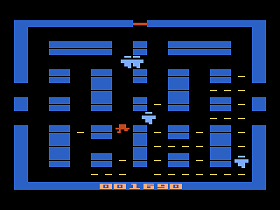 The Game: You’re in charge of a getaway car loaded with crafty criminals. Your job is to sneak around the maze, avoid four colorful cops who are hot on your trail, and grab all the dough – and, of course, to escape so you can steal again another day. But the cops can trap you with a series of doors that can prevent you from getting away… (M Network [Mattel Electronics], 1982)
The Game: You’re in charge of a getaway car loaded with crafty criminals. Your job is to sneak around the maze, avoid four colorful cops who are hot on your trail, and grab all the dough – and, of course, to escape so you can steal again another day. But the cops can trap you with a series of doors that can prevent you from getting away… (M Network [Mattel Electronics], 1982)
Memories: 1982. The year that everybody – and I do mean everybody – was trying to build a better Pac-Man. Mattel’s Intellivision console was suffering from the perception among mainstream gamers that the new, next-generation machine lacked arcade titles in its library; with titles like Major League Baseball, Mattel owned the video sports market. But this was 1982 and America had yet to sweat off Pac-Man Fever – sports games weren’t “in” at the moment.
Mattel inked a deal with Data East, which was carving its own niche in the arcade industry at the time with games such as Burgertime and the vaguely-Pac-Man-esque Lock ‘N’ Chase – cult favorites that Mattel now had access to. And not one to miss  an opportunity to make a buck, Mattel spun off a whole division – M Network – just to make versions of Intellivision games for the Atari 2600.
an opportunity to make a buck, Mattel spun off a whole division – M Network – just to make versions of Intellivision games for the Atari 2600.
Lock ‘N’ Chase on the 2600 is a fairly good example of a typical M Network game. At the very least it was fun, and sometimes it was an interesting exercise in adapting the Intellivision aesthetic to the 2600: the distinctive Intellivision alphanumberic characters and graphical style were ported to the 2600 quite well. Where some of the finer graphic detail was concerned, however, the 2600 can’t quite cut it for this game. The details of the maze itself are important in Lock ‘N’ Chase, as they help you determine where the doors are. Some of that detail is lost, so playing Lock ‘N’ Chase on the Atari is sometimes just  a bit hairier than playing the real thing.
a bit hairier than playing the real thing.
Overall, it’s a dandy translation, and a bit truer to its source material than Atari’s Pac-Man ever had a hope of being.